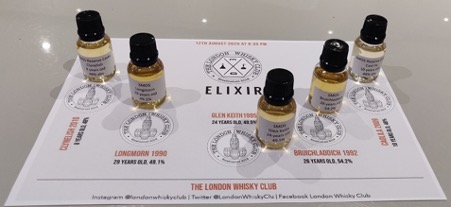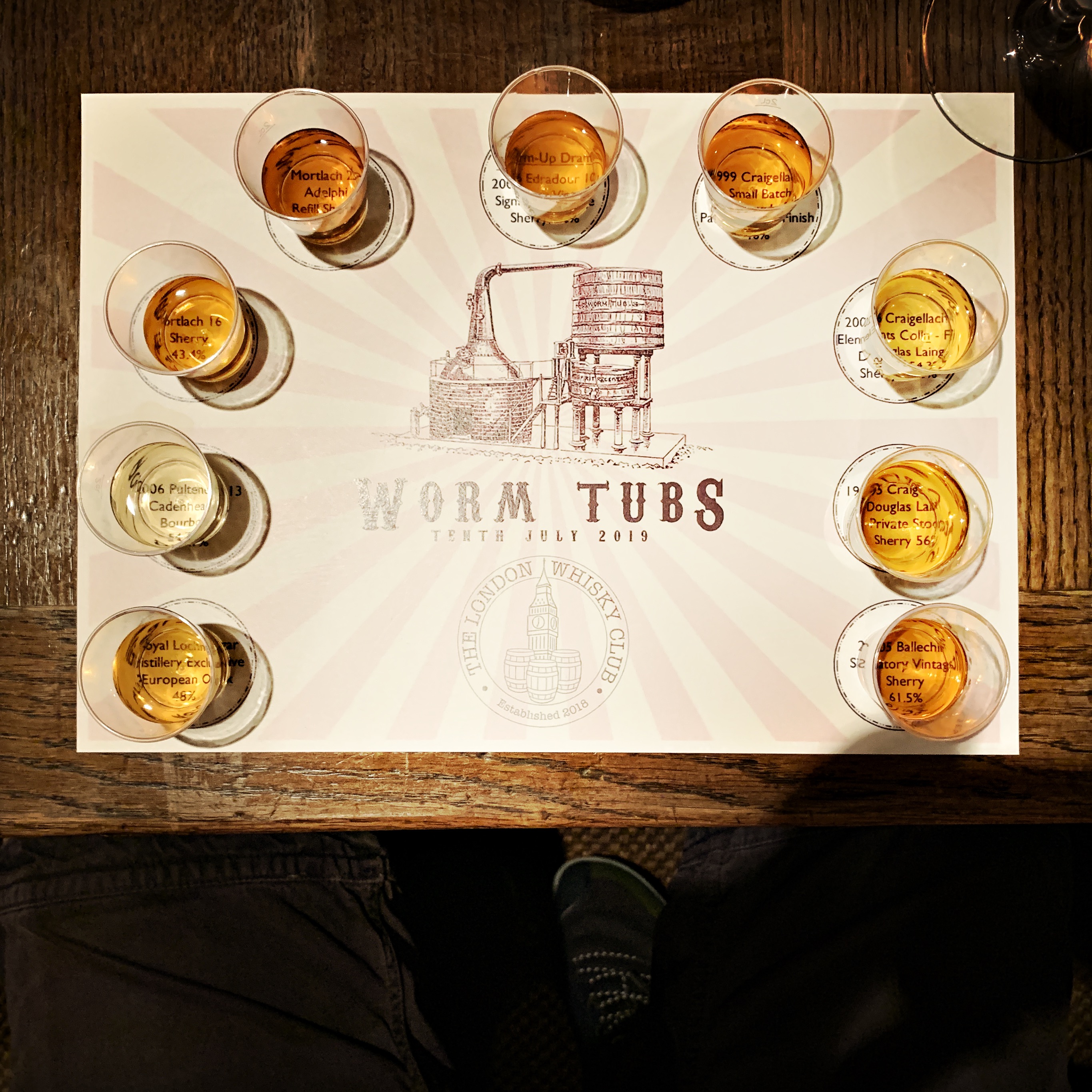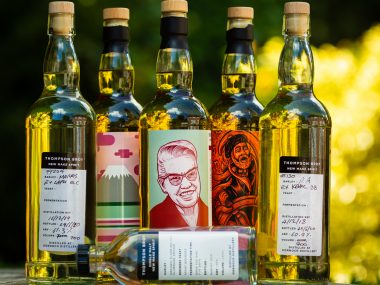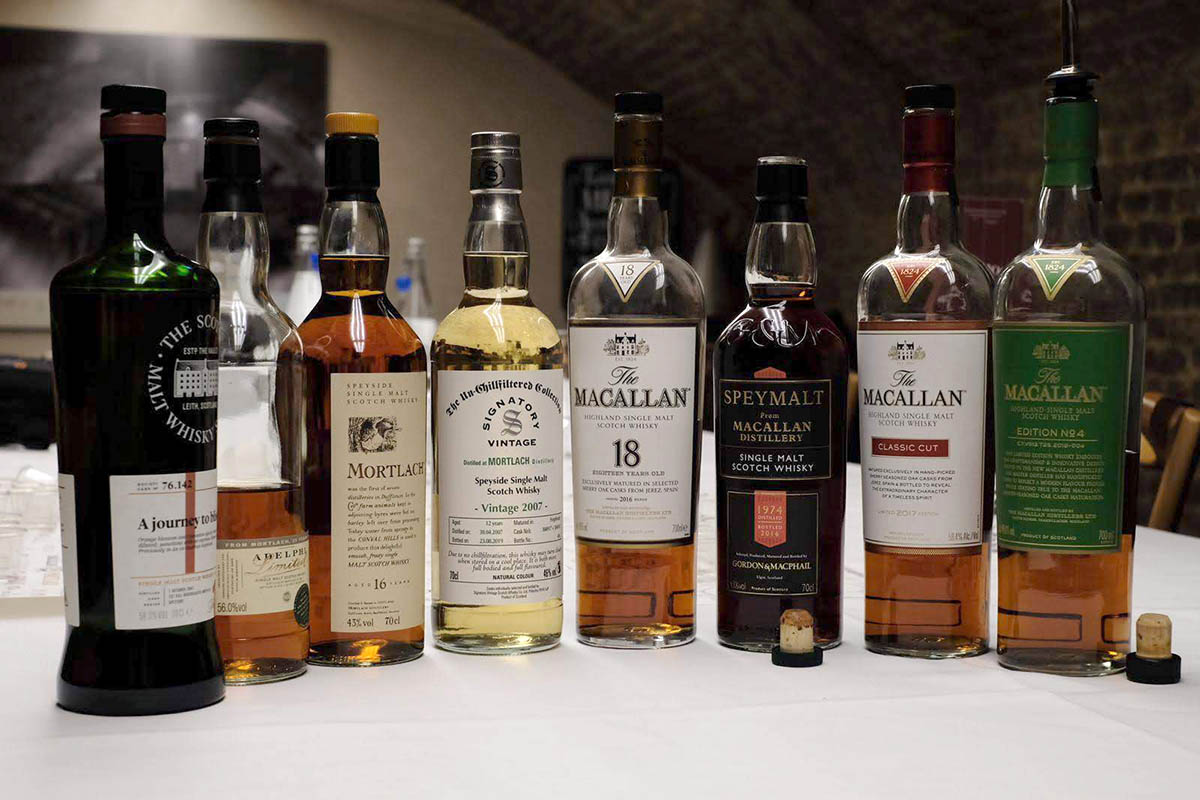Write up by Luke Jones…
This week’s virtual tasting from the London whisky club sees a collaboration with Elixir Distillers. For those that may be unfamiliar with the name, I’m sure you will have come across some of their work or even their previous name, Speciality Drinks. Elixir Distillers consider themselves a creator, blender and bottler of fine spirits. Some of their core brands include Port Askaig, Elements of Islay and SMOS (Single Malts of Scotland).
The co-founders and owners of Elixir Distillers are Sukhinder Singh and Rajbir Singh who may be better known as the founders and owners of the Whisky Exchange which was founded back in 1999. The Elements of Islay range was the first range to be launched in 2008 and shortly followed by Port Askaig in 2009. In 2017 the independent bottling side of the business was renamed from Speciality Drinks to Elixir Distillery. In 2002 they started Single Malts of Scotland because of the owners love of single cask single malts. They were buying single casks for their own pleasure and decided that there is no better way of doing this than bottling your own.
We were joined by Julie and Adele of Elixir Distillers to help us navigate through the drams.
As you can imagine there was a great line up on offer:
- SMOS Reserve Casks Clynelish 2010, 8 years old, 48%
- SMOS Single Cask Glen Keith 1995, 24 Years old, 49.5%
- SMOS Single Cask Longmorn 1990, 29 years old 49.1%
- SMOS Single Cask Bruichladdich 1992, 26 Years old 54.2%
- SMOS Reserve Casks Caol Ila, 10 years old, 48%

After a brief introduction to the background and formation of Elixir Distillers, Julie explained that the drams for tonight come from their new offering, the reserve casks. She stopped short of providing any details because in a novel move and a bit of a twist to the usual plan, the evening was going to be split into virtual break out groups to discuss the whiskies before coming back together to run through the detail.
And without further ado we jumped straight into our first break out room. After a bit of a slow start where we were still figuring out how this would work (at least in my group), there was an interesting, informal chat around our initial thoughts of the first dram. The dram in question was the Clynelish 2010, 8 years old. Then before we knew it, we were called back into the wider group. Lesson learnt, less chit chat, more whisky.
Before discussing our collective thoughts, Julie provided some background to the distillery. Clynelish started back in 1819. During the boom in the 1960s, Clynelish started going big into the blends, and to cope with the increased demand and therefore production, Clynelish opened a new distillery in 1967. The two distilleries ran side by side and were known as distillery A and distillery B. In 1969 the original distillery (A) was shut down with the new distillery (B) continuing and is the one still standing today. Meanwhile on Islay, Caol Ila closed for 1 year to perform a refurbishment which meant Johnnie Walker was missing the source for its smoky taste for its blends. So the original Clynelish distillery reopened in 1969 as Brora to supply Johnnie Walker, but sadly closed in 1983 for good. The standard Clynelish is the 14yo which was first introduced in 2002. This is typically what goes into Johnnie Walker gold and sometimes an independent bottler is lucky enough to get hold of it.
The second dram of the night is Glen Keith 1995, 24 Years old so back to the breakout rooms we went, albeit in a different room/group of people. This time my room included Julie. We took the opportunity to ask about the typical taste profile for Glen Keith. Julie was being a little cagey until we went back to the wider group, but we were able to tease out of her that the taste profile is light and fruity. This is typically used in blends to add the fruity notes. I think it’s fair to say we were a little underwhelmed by this. It was a more simple whisky and lacked the complexity we typically go for. Water and time opened this up a bit and brought the sweetness out but there was still a lack of finish.
Back into the main room and to the background of the distillery. It started up in 1957 by Chivas and is considered a modern distillery. After many years of experimenting with things like peat v no peat, different barley etc, in 1980 they installed a microprocessor to control all aspects of the distillery to maintain a level of consistency and in 1983 a 6th still was installed. The distillery was mothballed in 1999 but bought by Pernod Ricard in 2001. It underwent a renovation and reopened in 2013 with the plan being to produce 6m litres per annum, all for blends like Chivas Regal. This offering is one of only 256 bottles and as the dram opened up it did become more drinkable but was still a little flat for me.
Next up, the Longmorn 1990, 29 years old. This was scored highly by Serge Valentin and as expected it quickly flew off the shelves. We were lucky enough to have the last bottle. And off to the groups again where we all agreed this was a good dram and if anything tasted like a stronger dram. It’s a typical longmorn but more punchy which is probably be attributed to the age.
Founded in 1893 with production starting in 1894, the distillery has been subject to several take overs. In 1898 it was first taken over when the then owner was hit by financial troubles. In 1970, Longmorn joined Glenlivet and Glen Grant to form The Glenlivet Distillers Ltd. This was subsequently bought by Chivas Brothers in 1978 and in 2001 Chivas Brothers was acquired by the French Pernod Ricard Group. Given the distillery was owned by a group known for its blends its no surprise that it’s very common for it to be used in blending. The house style is very much a rich and sherried taste. This bottle is one of only 104.
The penultimate dram for tonight is the Bruichladdich 1992, 26 Years old. Back into the break out room we took the opportunity to briefly discuss the merits of the break out groups. Back to the dram and it drinks like a lower abv dram with a lot of character. It further opened up with a dash of water and it also restricted the peat. The distillery considers themselves non-conformist and progressive. They use only Scottish barley and it’s the one remaining distillery on Islay to use an open top mash tun. It was built in 1881 by three brothers but after a family argument (even before the distillery was completed) only one of the brothers remained to run the distillery until his death in 1936. There were a few subsequent owners until 1994 when it was shut down. Fortunately for us it found a buyer and reopened in 2000. In early 2001 it was completely dismantled and renovated but still holds all original features. In 2012 it was bought by Rémy Cointreau but a condition of the sale was that the distillery would continue to be run in the same way. Tonight’s dram was an unpeated whisky which is a bit of a rarity with only Bunnahabhain and Caol Ila doing both peated and unpeated whisky. Bruichladdich keeps its peated offerings as Octomore and Port Charlotte. Again, a limited offering with only 231 bottles. Despite this being an unpeated whisky, most if not all of us good get some peat from it. Given unpeated barley was used there were a few conspiracies being thrown around about was the peat coming from the cask, equipment or somewhere else.
The last dram of the night was the Caol Ila 10 years old. This didn’t drink like a 10yo with a lot of character and texture in the glass. It was generally well received in the breakout room and in the wider group. The distillery was built in 1846. It was taken over when the owners got into financial difficulty. In 1863 the new owner was also declared bankrupt and it was taken over again. In 1870 there was then a very extravagant expansion and during this time all current whiskies were sent to head office to be used in blends. The distillery was closed in 1930 due to the whisky slump stemming from the US prohibition and reopened in 1937 but closed again for the war. In 1972 the whole distillery was demolished to make way for a larger distillery to cope with the increased demand from blenders. The most recent takeover was by Diageo in 1997 and in 2011 there was a major revamp with a new washback, mash tun and more importantly a capacity increase to 6.5m litres. As previously discussed, a significant amount of Caol Ila goes into Johnnie Walker blends and only a small amount goes into single malt, but luckily for us there is plenty to go around.
Before we wrapped up there was the standard vote for “Dram of the night”. Top of the chart for tonight was the Bruichladdich. Unfortunately, the Glen Keith got no love from the group and didn’t get any votes. Personally, my favourite was the Caol Ila.
Tasting Notes:
SMOS Reserve Casks Clynelish, 8 years old, 48%
Nose: Lemon, citrus, cloudy apple juice, boiled sweets, herbal, honeycomb.
Taste: Honey, custard, oily texture.
SMOS Single Cask Glen Keith 1995, 24 Years old, 49.5%
Nose: Lime, zesty, tobacco, fresh cut grass, pears, lemon, cereal.
Taste: Sweet, apple, pear, light fruit, sharp.
SMOS Single Cask Longmorn 1990, 29 years old 49.1%
Nose: Aniseed balls, star anise, fruity, spicy ginger, caramel, coconut.
Taste: Chewy, buttery, oily, waxy, chocolate, cream, honey, toffee, orange, syrup.
SMOS Single Cask Bruichladdich 1992, 26 Years old, 54.2%
Nose: Light, floral, peat (no smoke), lime zest, hay, sawdust, toffee, liquorice.
Taste: Peat, spice, heat, pepper, oil, syrup.
SMOS Reserve Casks Caol Ila, 10 years old, 48%
Nose: Costal, smoky, lemon, salt water.
Taste: BBQ meat, caramel, syrup, pepper, toffee, chewy.
—————————————————————————————-
The next club virtual tasting from the Chapter 7 is set be the evening of Wednesday 26th August.




